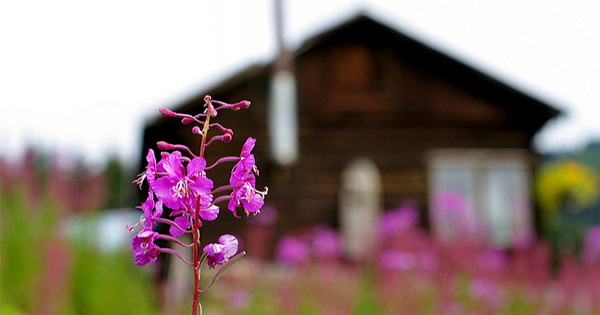
I went for a walk with Wendy the other day to the place where she grew up. At least that’s how she describes the old log cabin that she and her husband, Peter, lived in during their 20s, when they first came to Alaska. They had left their lives in Northern California—Peter had just finished college and Wendy nearly so—and rolled their Volkswagen Beetle onto the ferry in British Columbia. They befriended a man onboard, and soon after arriving in Alaska, they were having dinner at his mother’s Anchorage home. There they met another man, who encouraged them to travel to Homer, find his cabin, and live in it. That’s how Alaska was then: trusting, the whole state one small community. They ended up spending nearly a decade in the place.
By the time Wendy and I got to the cabin, we’d already seen so many ways in which her neighborhood had changed in the four decades since she’d left. We had parked her little red sedan with the new car smell still in it at the edge of a wide, smooth gravel road. In Wendy’s time, the road was just a narrow dirt track. A handful of houses had gone up too. And a new road was being hacked through spruce woods, leaving the ground spongy and naked and the trees toppled haphazardly. Despite the change and the passage of time, Wendy navigated us to Grant Fletcher’s cabin, a handsome place built in the 1970s. It was now overtaken by squirrels.
Likewise, the nearby cabin where the Johnson brothers lived, put up in the 1940s or 1950s by homesteaders who had preceded them, was now sinking into the meadow on which it stood. The brothers had greeted Wendy and Peter stark naked and steaming from their sauna when the young Californians first wandered by in search of the cabin they’d heard about in Anchorage. Wendy and Peter shared many moose dinners with these eccentric brothers, who drank vigorously, slept in the same bed, and didn’t work during the winter. Being so far from town made for a rich social life, Wendy explained. She used to ski for miles to dinner parties that turned into overnighters.
“That’s the view I remember,” Wendy said as we came out of a clump of spruce and saw her cabin in the distance. She had taken a job as a tutor at the local elementary school when they first got to town. Peter stayed home and kept the place warm. In the late winter afternoons, when stars were beginning to blink into a darkening sky, she’d ski back to the cabin and come around those trees to find the little house glowing yellow with light from oil lamps, smoke rising from the chimney.
Wendy and Peter hauled water from a nearby spring. Peter built a sauna for washing and added a porch to the front of the cabin. They kept chickens, goats, and pigs. “Everything was new,” she said. “Getting wood was new.”
Wendy, who wears her white hair swept up elegantly, wondered why I had asked her to walk with me to her old place. I couldn’t answer the question. I suppose I hoped that some mystery—about the passage of time, about change—could at least be partially solved this way.
We went inside. In the front room—the kitchen—Wendy pointed out the white enamel wood-burning cook stove she and Peter had brought up from Outside. “That was my first carpentry project,” Wendy said, pointing to a narrow corner shelf attached to the insides of the logs where they kept their music tapes. The bedroom beyond held a rusty barrel stove, a plywood bed, and an old rug. The beautiful headboard Peter had made, Wendy said, was gone. Nothing was square anymore.
“It’s not easy to find your past, to find out who you were then,” Wendy said as we walked away in the sun. In the years following her life in that cabin, Wendy has worked as a commercial fisherman, built a nice house closer to town, become a poet, written the text for the main exhibit at the local museum, and taken up a second residence in Vietnam. Maybe that, somehow, was the answer. Even if you go back, even if you walk back through the same trees and across the same meadows, you can never go back.

